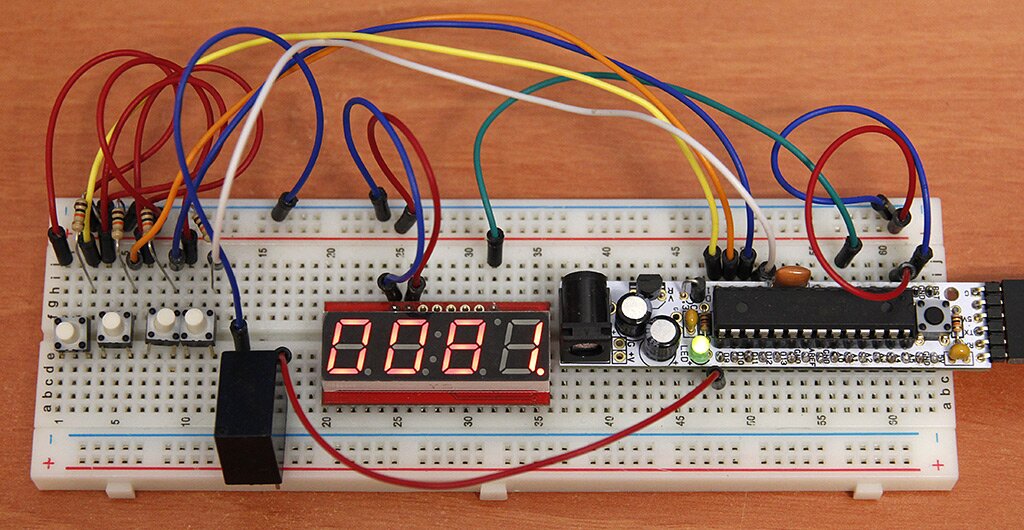Finally I’ve finished the first official release of the Intervaluino Plus. The name comes from the concept of extending the capabilities of the previous Arduino intervalometer called Intervaluino made by Timm Suess.
An intervalometer is basically a device that triggers an action every certain amount of time, and in photography it is used to create time-lapses.
My Intervaluino Plus uses a small Arduino compatible board called RBBB. I used it because I want to put all this components in a small box with a 9 volt battery and an Arduino Duemilanove (the first board I bought in Japan) or the more recent Arduino Uno wouldn’t fit inside. Either way, you can use an Arduino board as soon as it is compatible with the RBBB, Arduino Duemilanove, Arduino Uno, etc. Beware that the RBBB does not have a USB port so you will need a FTDI-TTL cable to connect it to the computer (you’ll need to install the drivers for your operating system too).
Intervaluino Plus is configurable via 4 buttons: left, right, up and down and comes with a 4 digit 7 segment serial display (Sparfunk COM-0976X) that only needs one line to be controlled. Here is a video showing how it works. I’ve replaced the trigger part so you can see clearly when it shots the pictures:
Left and right buttons are used to change the menu option whereas up and down change the value of the options themselves. When Intervaluino Plus is switched on it asks how many pictures have to be taken by displaying the text “PICS“. We can then use up and down to increase or decrease the amount from 1 picture up to 9999. If you are thinking that you don’t want to push the botton 9999 times you are as lazy as me ![]() So I implemented a “fast forwad” that makes the counter go faster if you leave the button pushed for some time. Also to know that you are on the first option the first dot down on the right of the display will remain on.
So I implemented a “fast forwad” that makes the counter go faster if you leave the button pushed for some time. Also to know that you are on the first option the first dot down on the right of the display will remain on.
Once we have selected the amount of pictures to take we can push the left button to go to the next menu option, which is called “PERI“. It represents the period of time we want between every picture. We can configure it from 1 second up to 9999. This time you will see that the second dot is on, representing that we are changing the second option.
We are now ready to take pictures! Just push the left botton once more and the display will show “PHOT” and the Intervaluino Plus will start taking pictures. Once finished the job Intervaluino Plus will go back to the first option again.
There is a “hidden” feature so you can adjust the display brightness on power up. If you turn on the Intervaluino Plus while you maintain the up button pushed the display will bright at the highest level whereas maintaining the down button will make the display barely bright. Use this option to safe battery or if the light conditions prevent you from reading clearly the digits.
The SOURCE CODE is available in my github repository and you can see the schematics right here:
This is the parts list:
- 1x Arduino compatible board, a RBBB for example.
- 1x Sparfunk COM-0976X 4 digit 7 segment serial display.
- 1x 4n35 or 4n25 optocoupler
or a 5V relay (JZC-11F-05VDC-1Z for example)UPDATE: The relay introduced a rebound effect that made the camera took 2 pictures in a row instead of just 1. - 4x push switches.
- 4x 10KΩ resistors.
- 1x 330Ω resistor if you use the optocoupler.
- 1x connector for your camera cable. Female 2.5mm stereo jack for Canon DSLR.
To create the breadboard drawing and the schematic I used Fritzing. You can download the schematic of Intervaluino Plus here.
In following versions I want to make at least those improvements:
- Change the limit of 9999 pictures and 9999 maximun seconds between every picture.
- A “
BULB” option so the shutter stays open for a period of time configured in the options. - Texts longer than 4 characters that will scroll on the display.
- Add another button to use it as an “enter” key.
If you find a bug or want to improve the Intervaluino Plus don’t hesitate to contact me.









